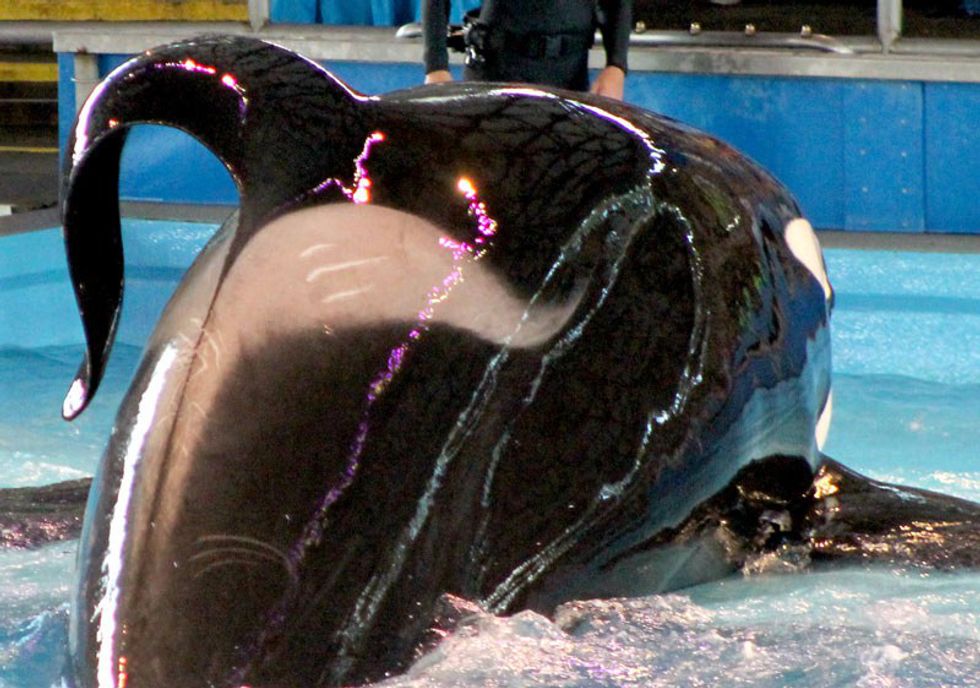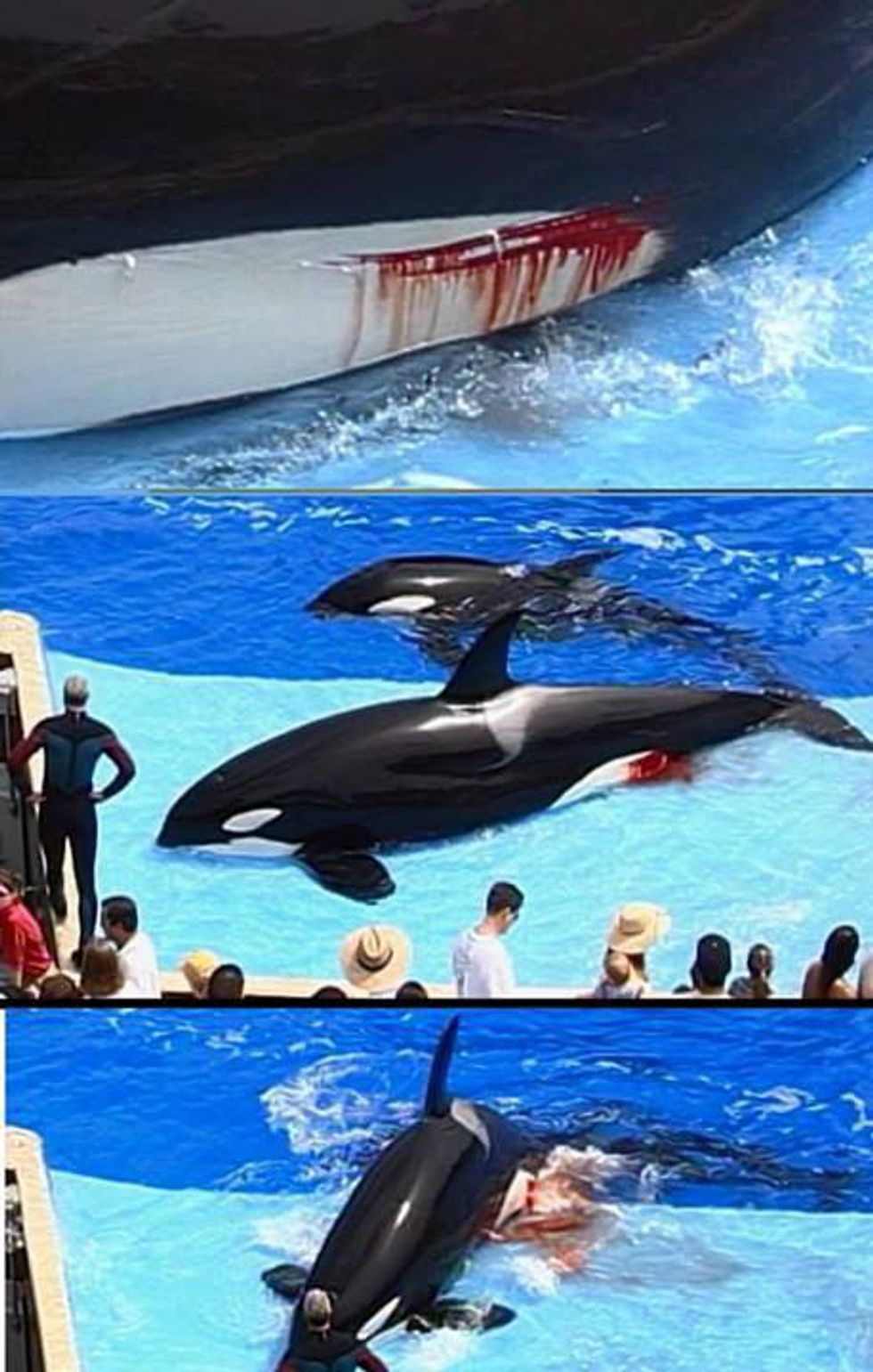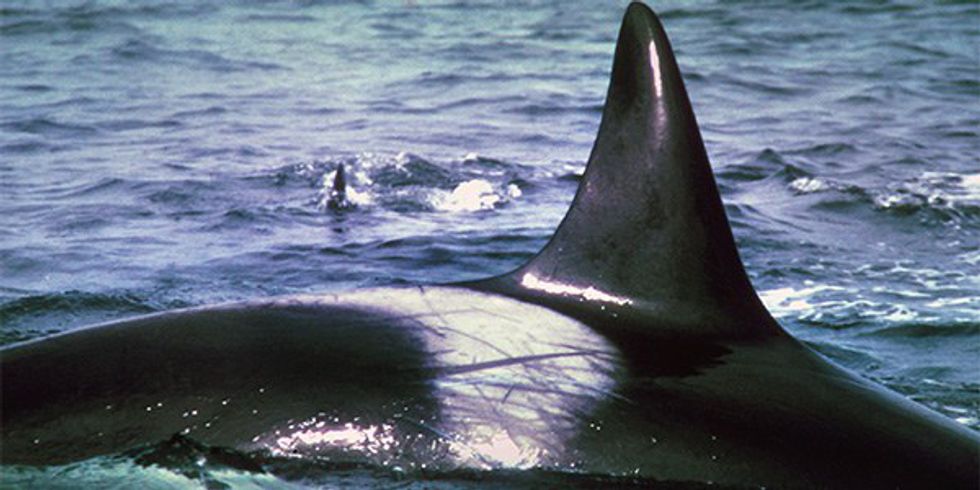Swimming gently alongside its mother, the young orca calf is seeing the bright blue waters for the first time. Reaching deep within itself, it pulls out knowledge that no one has to teach it: how to breathe, how to swim alongside its mother, and how leaving her side is sure to spell certain death. When the mother rises for air, the calf will as well. When she dives, it will follow. Always close by, so close, that they are almost touching. The mother will not leave her calf, not until it is ready to branch out on its own or become a fully integrated member into the pod.
As the calf grows, it becomes more adventurous and more independent of its mother. It takes actions, such as jumping and splashing on her own, learning the pod’s individual language. One day, this orca calf will become the next matriarch of the pod, and the only danger she will ever face is from the hands of the humans that decide whether or not her pod can survive. For Amaya, the youngest killer whale at SeaWorld San Diego, the next couple years will spell out life and death for her kind. And being so young, so naïve, and so innocent, she will never know that her fate is sealed, and she never got a chance to put her voice into the mix.
Killer whales are social creatures, much like horses, lions, and zebras. They rely on each of its members to help play their own individual part, in order to ensure the survival of their species. Killer whales, like Amaya, who were born and raised in captivity, will never meet the cruel hand of mother nature, whose mood is always changing the ocean’s currents, nor be exposed where boat propeller’s, contamination, and human noise pollution are threatening her wild counterparts very lives and wellbeing. Nor will she ever face the terrors of not being able to find food and suffering many endless nights and days with no food, because the supply is dwindling.
Amaya and her pod mates will never know these challenges. The threat that they have to face cannot be stopped by more conservation efforts nor will they ever be affected by her own actions. The threat she faces comes from organizations such as PETA (People for the Ethical Treatment of Animals), who are under the impression that the animals in captivity are suffering and that the industry as a whole must be put to a stop.
Their reasoning behind wanting to end the captivity of animals comes from the belief that animals share the same moral laws that we do, and in doing so, deserve the same humanistic rights that we are granted. Would it be right to cage up a human being? Would it be right to force your neighbor to live in a bathtub? This type of rhetoric fuels animal’s rights ads and ideas, and leaves a lasting impression through the voice of documentaries such as Blackfish, which challenge the ethics behind keeping wild animals in human care for the very same reason. They have feelings. They have morals. Shouldn’t we give them the same basic rights?
In order to understand whether or not this line of reasoning holds any basis we need to first understand the basics of Moral Law and Instinct. Moral Law is the standard to which we measure whether an action or idea is right or wrong. This is the part of our being that tells us that stealing is wrong, murder is wrong, and that we should risk our lives to save our fellow man. Instinct is the feeling that we need to take action in order to ensure our survival, this can take place as the want to eat, the want to engage in sexual activity, and the want to run away from scary situations. Now that we understand the working definitions of both Moral Law and Instinct we can begin to break down whether or not Killer Whales follow Moral Law.
Since Killer Whales are highly intelligent creatures, they have invented cunning and new ways to hunt. One of these ways is to perform a move called a slide out, in which a Killer Whale purposely beaches itself in hopes of catching seals that are playing past the breaking point of the waves. This move is highly dangerous to young calves learning this maneuver for the first time for they have the high possibility of getting stuck. When this happens, the mother killer whale will stay at a safe distance, but through a series of clicks, high pitched squeals, and slapping of dorsal and tail fins will try and encourage the necessary sequence of actions that its calf has to take in order to get unstuck. The mother killer whale will not though, risk its life to go save its calf. If the calf dies on land, then the mother just swims away. Her instinct for self-preservation is stronger than the instinct to go save her young.
In contrast, humans work the opposite. If we were to see one of your friends or family members drowning, we would jump in, despite the danger that it puts us in, to go save them. This would be the Moral Law at work. We have the two instincts, the mothering instinct to protect those around us and the flight instinct, get away from danger. Moral Law is the feeling that tells us to act on the weaker of the two instincts, which in this case, would be to jump headfirst into danger and save our fellow man.
It can still be argued that, what about Killer Whales in SeaWorld’s care, who, despite the instinct of preservation, decide to partake in dangerous activities due to stress, such as raking or beaching themselves on the slide-out. Both of these are good questions but once again can be explained through natural Orca behavior.
Killer whales do not have hands and there for are unable to communicate through physical contact like humans. Instead, they use their teeth to show affection, to grab another whale’s attention, correct misbehavior, and to show dominance. In order to get a clearer understanding of what these types of rakes look like, I will break down each of them. Starting with raking to show physical affection.
Killer whales will often swim close by a fellow pod mate and gently rake their teeth over their skin. This is the equivalent of me giving my roommate a pat on the back or giving my sister a hug. It is harmless and does not hurt the animal in any way. This “love tap” kind of rake mark is characteristic by just scratching the surface of their skin and usually fades away in a couple of days.
The second form or rake which is two enforce corrections on behavior is a little bit deeper and may leave behind a tiny scar on the Killer Whale’s body, but is harmless to the animal itself and cannot be seen unless you are up close to the animal. A great example of this, would be during a show at SeaWorld San Diego, one of the younger orcas, named Makani was out in the show pool with his mother, Kasatka. Kasatka was asked to do a breach in the middle of the pool while Makani was asked by the trainers, to stay towards the back of the pool. Makani, being young and slightly rambunctious, ignored the commands of the trainer and instead darted after his mother in the center of the pool. Kasatka ended up abandoning her breach in order to avoid hitting Makani, who had decided to do tricks of his own in the center. Kasatka, to teach Makani a lesson, darted after him, in which Makani responded by trying to swim away. He wasn’t fast enough and received a rake mark on his left side, but once the rake mark was received, both whales settled down and the show proceeded as normal.
The final type of rake comes from aggression. These rakes do leave behind visual scars and can occur for any number of reasons. The first one is to show dominance. For example, Orkid and Kasatka got into a fight before a show because Orkid was taking the lead position for some of the group behaviors the whales were practicing with their trainers. Kasatka, in order to remind Orkid of her place, ended up fighting Orkid for dominance. The end result led to Orkid sliding up on the front stage slide-out and waiting for Kasatka to calm down. The veterinary staff were quick to respond, (making sure that Orkid was not hurt), and ended up pulling Orkid from the rest of the show. After the show had ended, Kasatka and Orkid began to swim with each other in the back pool, as if nothing had happened. The only difference was that Kasatka had complete charge and Orkid wasn’t going to challenge that authority.
Rakes are just as common in the wild as they are in captivity. Rakes do not just come from high stress situations but can mean a multiple of different things. To think that raking is bad, is a misunderstanding of the animal’s behavior and trying to suggest that the severity of the rakes seen on SeaWorld’s Orcas tell of their sad state is just ridiculous. All killer whales have rake marks on them, as mentioned earlier, it is solely a form of communication, and though sometimes the end result may seem ugly, rakes are never meant to seriously harm another whale. It is just meant to be a warning or an affirmation of behavior.
There are other behaviors that PETA also attacks as unhealthy such as the rubbing against tank walls and floors. Thought these behaviors are also common among wild crustaceans, such as Killer Whales, who use the ocean floor as a way to scratch off dead skin. Rubbing against the wall and floor of a tank is the same premise.
The point I am trying to make by sighting these examples is that all of SeaWorld’s Killer Whale’s behavior can be easily explained by just understanding their natural and instinctual behaviors. If it wasn’t for SeaWorld’s Killer Whales and other animals, it would be nearly impossible for us to have this kind of information. Institutions like SeaWorld allow us to get a better picture into the lives of these magnificent animals without disturbing their daily lives. For SeaWorld’s Orcas, whether they know it or not, they are ambassadors for their wild counterparts and they inspire people every day to make a difference in our world to help protect their species.
The only threat these animals face come from the ignorance that is being spread around by organizations like PETA because they are putting emotions over reason. SeaWorld announced recently, that because of changes in public opinion, they are going to stop the breeding of Killer Whales in their care, meaning that the orcas that remain are the last ones. Keeping Killer Whales from partaking in something so natural as mating will not only disrupt their instinct to preserve their species but it will also cause more stress on the animal, when it realizes that it no longer can function from the same behaviors it has grown up its whole life knowing. Care for the pod, raise the young, and keep order within their family unit.
If our emotions are leading us to blindly act, without knowing the full extent of our consequences then we will find our world becoming darker and darker, as more animals begin to pass away and suffer, because we personally feel like they are unhappy. Those who support PETA and the ending of animal captivity may feel good about their actions but animals like Amaya, who have no say, well, their fate is in our hands and we have to be careful about where we take them. If we truly want to do what is best for the animals, we need to learn to put our emotional ties aside and look at all the facts.
























